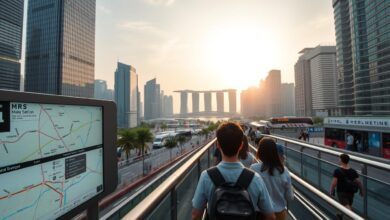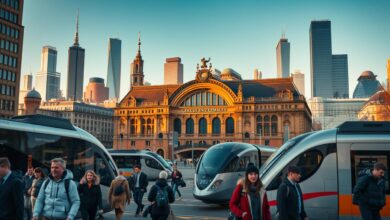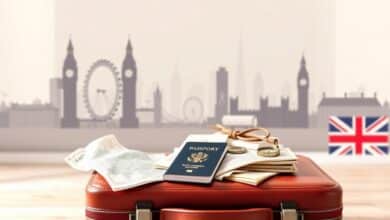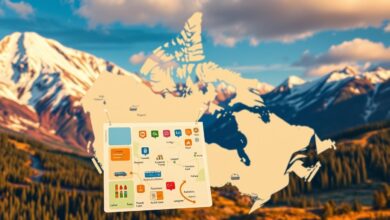From Museums to Markets: How to Explore Italy Like a Local in 7 Days
Italy is a treasure trove of culture and history. It offers many ways for travelers to dive into local life.
Anúncios
This guide is for those who want to go beyond the usual tourist spots. Over seven days, it will show you how to see Italy like a local, uncovering hidden spots and real experiences.
Each day, we’ll explore a different city. You’ll learn about key activities, tasty foods, and cultural events. From bustling markets to famous museums, every moment will make you appreciate Italy’s heritage more. This guide will also share tips on navigating Italy’s streets and customs, making your trip unforgettable.
Day 1: Arriving in Rome, the Eternal City
Arriving in Rome is an exciting first step towards experiencing the rich culture and history of this magnificent city. With a few practical tips and insights, travelers can navigate their arrival seamlessly and start their journey on the right foot. The following sections cover essential advice for navigating Fiumicino Airport, reaching Central Rome, and exploring local transportation options.
You will be redirected to another website
Tips for Navigating Fiumicino Airport
Fiumicino Airport is Rome’s main international gateway, welcoming millions of travelers every year. Knowing the airport layout can ease initial stress. The airport has Terminals 1, 2, 3, and 5, serving different airlines.
Pay attention to signs for baggage claim and passport control. Currency exchange services and transportation information desks are also available. They help with smooth transitions.
Getting to Central Rome
Several transportation options lead to Central Rome after leaving the airport. The Leonardo Express train is a popular choice, taking about 30 minutes to reach Termini Station. Buses and taxis are also available.
Pre-booking transportation can offer convenience, especially after a long flight.
Local Transportation Options
Once in Central Rome, many public transportation options are available. Buses, trams, and the metro cover the city. For those seeking economical alternatives, the ATAC transport card offers unlimited access to public transport.
This makes it a savvy choice for travelers interested in local experiences in Italy.
Day 2: Discovering Ancient Rome
Italy’s capital city is full of ancient history and amazing architecture. Exploring Ancient Rome’s landmarks reveals its grand past and hidden gems. It’s a chance to dive into the city’s rich culture.
Must-Visit Historical Sites
The Colosseum, Roman Forum, and Palatine Hill are top sights in Italy. The Colosseum shows the Roman Empire’s love for entertainment. The Forum gives a peek into ancient Roman politics and society. Palatine Hill offers views and insights into the lives of emperors.
Visiting the Colosseum and Forum
A guided tour of the Colosseum reveals its deep history. It recalls the events that thrilled thousands. Next to it, the Forum was where Romans talked and traded. Walking through these ruins lets you picture the city’s life long ago.
Enjoying a Traditional Roman Meal
End your day with a traditional meal at a local trattoria. Try dishes like Cacio e Pepe and Carbonara for a taste of Rome. In places like Trastevere, you can enjoy local wines and the real atmosphere. This meal is a key part of Rome’s cultural journey.
Day 3: Art and Culture in Florence
Florence is a city full of art and culture. It attracts many who want to explore its rich history. Here, you can see Renaissance masterpieces and iconic buildings. An Italy local travel guide can help you find hidden spots and shortcuts.
Exploring the Uffizi Gallery
The Uffizi Gallery is one of the world’s top museums. It has an amazing collection of Renaissance art. Make sure to book your tickets early to avoid long lines. A guided tour can help you understand the art better.
Local Tips for Visiting the Accademia
The Accademia Gallery is known for Michelangelo’s David. Visit on weekdays or early mornings for a quieter experience. This way, you can enjoy the artwork more. There are also other interesting pieces to discover.
Enjoying the Florence Cathedral
The Florence Cathedral, or Santa Maria del Fiore, has a stunning dome. Climbing to the top offers amazing views. Inside, you’ll find beautiful artwork and a striking façade, making it a must-see.
Day 4: Culinary Delights in Bologna
Bologna is known as Italy’s culinary capital. It has a rich food history that excites visitors. Travelers looking for real Italian food will love Bologna’s unique tastes. The city’s markets and dishes make for memorable food experiences.
Famous Local Dishes to Try
Bologna’s food scene is famous for its dishes. You must try Ragù alla Bolognese, a meat sauce with tagliatelle. Also, don’t miss the tortellini, filled with cheese or meat, showing the area’s farming heritage.
Best Markets in Bologna
Visiting Bologna’s markets is a great way to dive into local food culture. Mercato di Mezzo and Quadrilatero are lively spots. Here, you can find handmade goods, fresh meats, and cheeses, giving a peek into Bolognese life.
Cooking Classes for Authentic Experience
For a hands-on food adventure, take a cooking class. Bologna’s schools teach regional recipes. It’s a fun way to learn and enjoy Italy’s flavors.
Day 5: The Beauty of the Amalfi Coast
The Amalfi Coast is a dream destination with its beautiful coastlines, quaint towns, and tasty food. It’s a place where famous spots meet hidden treasures. For those looking for unique Italy experiences, there are many quiet villages and calm beaches to discover.
Must-See Towns and Villages
Exploring the Amalfi Coast means visiting its famous towns. Here are some must-sees:
- Positano: Famous for its colorful houses and lively beaches, it’s a feast for the eyes and taste buds.
- Amalfi: This town is known for its beautiful cathedral and lovely streets, perfect for strolling.
- Ravello: Famous for its stunning villas and gardens, it offers amazing views of the sea.
Hidden Beaches and Scenic Views
If you’re after peace, the Amalfi Coast has secret beaches. Fornillo Beach is a quiet spot with clear waters. For a hike, try the Path of the Gods for unforgettable views of the coast.
Local Transportation Tips
Getting around the Amalfi Coast can be tricky because of its narrow roads and parking issues. Public buses are a good way to travel between towns without driving. Ferries are another great option for seeing the sea while moving between places. These methods help you enjoy the views without worrying about driving.
Day 6: Venice, the City of Canals
Venice is a city full of history and culture. It’s known for its winding canals and beautiful buildings. To truly enjoy Venice, you need to know its layout. It’s a top spot for those looking for a real adventure.
Understanding Venice’s Unique Landscape
Venice sits on islands, linked by canals. For newcomers, it can be hard to get around. A good Italy local travel guide can help. They offer maps and advice to see the best spots.
Recommended Gondola Rides
Gondola rides are a must in Venice. Sharing a gondola is cheaper but still magical. Try it at sunset for a romantic view of the city.
Exploring Local Shops and Markets
Venice is known for its handmade goods, like Murano glass and lace. The Rialto Market is a must-see. It’s full of fresh seafood and local food. It’s a great way to see Venetian life up close.
Day 7: Final Day of Adventure in Milan
On the last day in Milan, you can dive into the city’s culture, fashion, and food. Milan is a top spot in Italy, mixing old landmarks with a modern vibe. This day will be filled with amazing sights and tasty meals.
Visiting the Duomo di Milano
The Duomo di Milano is a stunning Gothic building and the world’s fourth-largest cathedral. It’s a key place to see Milan’s art. Climbing to the top gives you incredible views and lets you see the detailed designs up close.
Fashion and Design District Insights
Milan is known for its fashion, offering a unique shopping experience. Places like Brera and Via Montenapoleone have high-end boutiques and designer stores. For those who love style, these spots are a must-see. You’ll get to see local fashion trends, adding to your travel memories.
Local Cuisine and Dining Experiences
Milan is a food lover’s dream, with dishes like Risotto alla Milanese and Ossobuco. Eating at local osterias and enotecas lets you taste real Italian flavors. You’ll enjoy Milan’s food scene and the cozy feel of these places.
Practical Travel Tips for Italy
Traveling to Italy means knowing a few key things to make your trip smooth. Knowing about money, local customs, and basic Italian can make your visit richer. These tips help you dive deeper into the culture.
Currency and Payment Methods
The Euro is Italy’s official money. It’s smart to carry some cash for small buys at local spots. Credit cards work well in big places, but cash is better in remote areas.
Local Etiquette and Customs
In Italy, saying hello is very important. Saying “Buongiorno” can make people friendlier. Also, waiting for everyone to start eating shows respect for local ways.
Language Basics for Travelers
Even though many speak English, learning some Italian is helpful. Saying “per favore” and “grazie” shows you care. It also makes talking to locals more enjoyable.
Essential Packing List for Italy
When planning a trip to Italy, think carefully about what to pack. The country’s weather and activities vary greatly. You’ll want to pack clothes and accessories that keep you comfortable. Plus, choosing eco-friendly options helps the environment.
Clothing Recommendations for Different Seasons
Italy’s weather changes a lot from north to south. In spring and fall, wear layers for the perfect temperature. Summer in the south means light, cool clothes are best. In the north’s winter, bring warm coats, gloves, and hats.
Must-Have Travel Accessories
Some accessories make traveling better. A power adapter keeps your devices charged. Wear comfy shoes for city walks. A reusable water bottle is good for your health and the planet.
Sustainable Travel Tips
Traveling responsibly in Italy is key. Choose trains over planes to cut down on carbon emissions. Eat at local spots and shop at markets to support the community. These actions make your trip better and help the places you visit.
Safety Tips for Traveling in Italy
When traveling in Italy, safety should be your top priority. Knowing the local laws and emergency contacts is key. Keeping your belongings safe is also crucial. Learning about local customs and rules can make your trip even better.
Understanding Local Laws
It’s important to know the local laws to avoid trouble. Rules about drinking in public and certain behaviors are strict. Knowing these laws helps you enjoy Italy’s culture without issues.
Emergency Contacts and Resources
Knowing emergency numbers is vital. In Italy, dial 112 for medical, fire, or police help. Knowing where the nearest hospital or police station is can give you peace of mind.
Keeping Personal Belongings Safe
Petty theft can happen, especially in busy areas. Use anti-theft bags and keep valuables close. Always be aware of your surroundings to protect your belongings.
Navigating Italian Public Transportation
Italy has a well-connected public transport system. It makes it easy to see its cities and landscapes. Knowing the train, bus, and tech options can make trips smoother. Here’s what to keep in mind for a better trip.
Overview of Train Systems
Trains are a top choice for getting around Italy. They cover both short and long trips. High-speed trains like Trenitalia and Italo connect big cities fast.
Booking seats early gets you the best prices. Always check the schedule before you travel to plan better.
Buses and Trams in Major Cities
Buses and trams are key in cities like Florence and Milan. They cover almost every area. Knowing the routes and buying tickets from machines or apps makes travel easier.
Italian tourism tips suggest planning ahead to avoid delays. This helps you enjoy your trip more.
Tips for Using Apps for Local Transport
Technology is a big help in Italy. Apps like Moovit and Trainline make travel easier. They give updates on when trains and buses arrive.
These apps are great for those new to Italy’s transport. Using them can make your trip more fun and stress-free.
Conclusion: Embrace the Italian Way of Life
To really experience Italy like a local, connecting with people is key. Talking to locals gives you a peek into their culture and traditions. Visiting family-owned shops or joining community events makes your trip unforgettable.
These moments help you appreciate Italy’s rich regional customs and tastes.
Building Connections with Locals
Getting to know Italians makes your trip better. Enjoying meals at family-run places or going to village festivals lets you see the unique stories of each place. It makes you feel like you belong, adding depth to your travel.
The Importance of Slowing Down
Italy teaches us to slow down in our fast world. Taking time for meals and strolls through old streets helps you understand Italian life better. These moments are key to experiencing Italy like a local, making every meal and chat a special memory.
Final Thoughts on Experiencing Italy
This guide shows you more than just sights. It’s about diving into local customs, food, and connections. By doing so, you’ll make memories that last a lifetime. To truly get Italy’s heart, you must live like a local.
FAQ
What are the best hidden gems to visit in Italy?
Italy has many hidden gems. Civita di Bagnoregio is a charming village. Tropea in Calabria is a lesser-known coastal town. Matera’s hills are picturesque.
These places offer real experiences away from the usual tourist spots.
How can travelers explore Italy like a local?
To explore like a local, try local markets and family-run trattorias. Take part in cultural activities like cooking classes or art workshops. Using public transport helps you move around cities like a native.
What local experiences should not be missed in Italy?
Don’t miss enjoying an aperitivo in a Venetian bacaro. Take a Vespa tour through Tuscan countryside. Explore Amalfi’s citrus groves.
These activities give you a deeper look into Italian life and culture.
What are some Italian tourism tips for first-time visitors?
Learn basic Italian phrases and travel off-peak for fewer crowds. Always try local dishes. Researching local customs can make your trip better and help you connect with locals.
How can I find the best attractions in Italy?
Use local travel guides and tourism websites. Check travel blogs for authentic experiences. Must-see spots include Rome’s Colosseum, Florence’s Uffizi Gallery, and the Amalfi Coast’s views.
What should I know about local etiquette and customs in Italy?
Greetings are key in Italian culture. Say “Buongiorno” or “Buonasera” to greet. It’s polite to wait for everyone to be served before eating in a group.
This shows respect for community.
Are cooking classes worth it while visiting Italy?
Yes, cooking classes are a great way to dive into Italian culture. You’ll learn about regional cooking and enjoy a meal together with others.
What are some essential packing items for traveling in Italy?
Pack comfortable shoes, a reusable water bottle, and a power adapter. Wear lightweight clothes in warmer months. A guidebook or travel app helps navigate attractions.
How can I ensure the safety of my belongings while traveling in Italy?
Use anti-theft bags and stay alert in crowded places. Avoid showing valuables. Keep passports and important documents in hotel safes.
Published on: 12 de April de 2025

Arturo González
Arturo González is the founder and lead writer of DebxCred.com, a platform created to help people make smarter and more informed financial decisions. With a degree in Business Administration and a specialization in Financial Marketing, Arturo built a solid corporate background before deciding to share his knowledge in a practical, easy-to-understand way.
Driven by a genuine passion for finance and education, Arturo turned DebxCred.com into a trusted source for detailed reviews of financial products, digital banking tools, and practical financial education — empowering readers to take control of their money with confidence.
In his free time, Arturo finds balance and inspiration while surfing — a hobby that reflects his calm yet determined approach to helping others build a healthier and more prosperous financial life.






